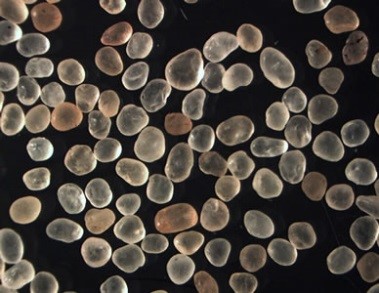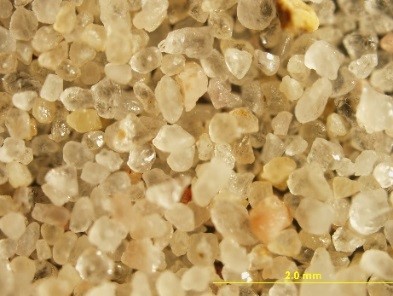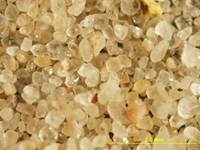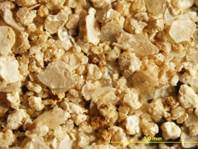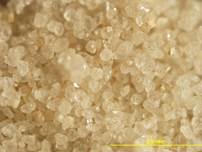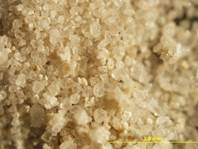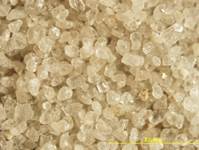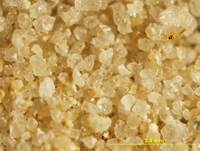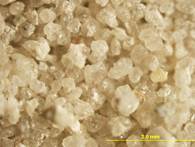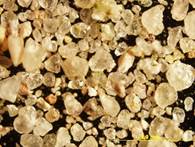Fracture (Frac) Sands in Kentucky
General Information
Sandstone suitable for use in hydraulic fracture well treatments (frac sands) are in high demand due to the shale gas revolution in the U.S. Shale reservoirs are stimulated for oil and gas production in many parts of the U.S. including the Bakken Shale in North Dakota, the Marcellus Shale in Pennsylvania, Utica Shale in Ohio and the Eagle Ford Shale in Texas. In Kentucky, the new exploration and development of the Berea Sandstone and Rogersville Shale, and continued development of the Devonian Ohio Shale may create the demand for a local source of frac sands. Frac sands function as a proppant to allow induced fractures to remain open during well completion operations. Thousands of tons of frac sand are required for one horizontal well, so the demand is great when multiple horizontal wells are drilled.
Specifications
Specifications for frac sands are established by the American Petroleum Institute and some service companies who perform the service of fracking the horizontal wells. Detailed specifications for frac sand can be found at the American Petroleum Institute website. Frac sand deposits are nearly pure sand or sandstone deposits that contain high-purity silica and have a specified grain size, sphericity, roundness, are acid or chemically compatible, contain high granular strength, and have low iron or other deleterious materials. Service companies may have specific requirements for frac sand quality. Tier I frac sands are normally .6 or higher (according to the Krumbein shape factors chart) in sphericity and roundness, whereas Tier II sands may have lower Krumbein values and be more angular in sphericity and roundness. Smaller grain size deposits may be suitable for natural gas fracs, whereas larger grain sizes may be needed for oil fracs. Examples of Tier I frac sands would be the St. Peter Sandstone in Wisconsin and a Tier II sand would be the Sharon Sandstone in southern Ohio. Economic frac sand deposits that meet the quartz grain criteria are usually easily mined and processed and located close to the site of large horizontal drilling projects, where transportation costs are reasonable.
Tier 1 photograph courtesy of http://www.rockproducts.com/frac-sand/14379-frac-sand-sources-in-the-united-states.html#.VZ0YlBvbIuR (Photo courtesy of Fairmount Santrol).
Potential Frac Sands in Kentucky
Many of the sandstone deposits in Kentucky probably do not meet the criteria of Tier 1 frac sands for hydraulic fracturing due to high angularity of quartz grains, numerous contaminants in the sand and the highly indurated nature of the sandstone bodies. However, the Kentucky Geological Survey (KGS) has compiled information that may be of interest in frac sand research and there may be isolated, friable sand bodies that contain clean, well rounded grains, but more site specific research is needed to determine their location and qualification as frac sands. Detailed geologic maps can also be created from the KGS online mapping service that show regional outcrop patterns of the various sandstones in the state.
The Kentucky Geological Survey has compiled a map of Pennsylvanian quartz rich sandstone deposits (Figure 1) and have listed several publications in the references that are related to sandstones and silica sands in the state. The report on sand and gravel along the Ohio River Valley (Amaral and Anderson, 1994) has extensive analysis and values for sphericity and roundness of the glacial sand and gravel deposits in northern Kentucky. Other older reports of silica sand deposits in the state contain chemical and sieve analysis of the sands, but do not contain frac sand specification measurements.
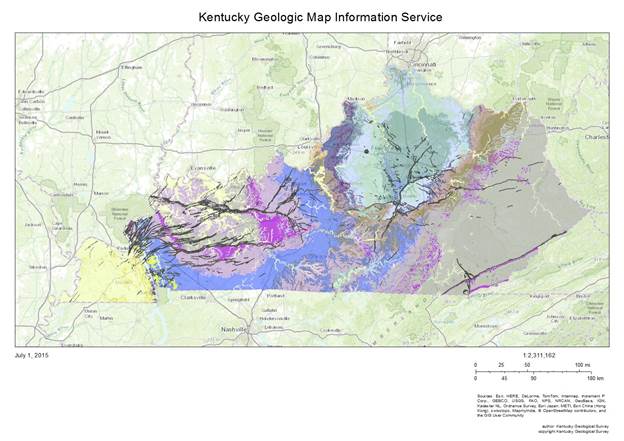
Generally, most thick sandstone deposits are the Corbin (Figure 2) and Lee Formation, which are basal Pennsylvanian sandstones in eastern Kentucky. These lower Pennsylvanian sandstones contain a thick sequence of sands and have been mined for silica sand near Corbin, Elkhorn City, Grayson and other sites along the Pine Mountain Thrust Fault. Another basal Pennsylvanian sandstone called the Sharon Sandstone in southern Ohio, contains rounded grains and is very weathered, easily mined and marketed as a Tier II frac sand. Most of the quartz sand in the eastern Kentucky sandstone bodies are highly angular, conglomeritic, and do not meet the sphericity and roundness requirements for a frac sand. Most of these deposits are indurated and some are friable, so mineability and transportation are an important criteria to qualify as an economic frac sand. One of the deposits in Pike County is near a rail line, but any deposits would require truck transportation.
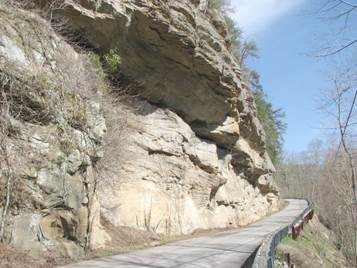
The Tradewater Formation and Caseyville are Pennsylvanian age sandstones and the Cypress, Bethel, Hardinsburg Sandstones are additional Mississippian age quartz sands in western Kentucky that are angular and probably do not meet the sphericity and roundness guidelines. These deposits are also highly indurated and would require extensive grinding to obtain a finished product.
Figure 3. Photographs of various Mississippian and Pennsylvanian age sandstones, showing mostly angular sand grains, however some of these might qualify for a Tier II frac sand. Sample Letter refers to the locations in Figure 1 and Sample Numbers identified in captions of these figures refer to samples from Report of Investigations No. 5, Series 9, 1952, which describes several of the above mentioned sandstones. These photographs may or may not be representative of their respective sandstone petrology since clastic sedimentology facies can change abruptly.
Additional Mississippian sandstones exist in the state, but these are thin and usually interbedded with shales. The Berea Sand, as noted in a recent USGS map, is very thin, but was mapped and grouped with the Sunbury and Bedford Shale, and is not as extensive as shown on their map and is probably not a potential frac source (http://www.rockproducts.com/frac-sand/14379-frac-sand-sources-in-the-united-states.html#.VZ0YlBvbIuR). In Kentucky, the USGS map also shows the Ordovician age St. Peter sandstone to be a potential frac sand source, but the St. Peter sandstone is not exposed on the surface in Kentucky, and it is intermittent in the subsurface at a depth of about 800 feet at its shallowest depth. This would not be a viable or economic source for frac sand. The St. Peter is exposed at the surface and mined as a high quality Tier 1 frac sand in northern Illinois, Wisconsin and Minnesota.
There are numerous sand and gravel deposits in northern Kentucky that that were formed from the glacial melt water outwash during Pleistocene glaciation (Amaral and Anderson, 1994). These deposits are very heterogeneous, poorly sorted and contain various sizes from clay, silt, sand, and pebble to boulder size rocks. Although these deposits are semi-consolidated, they contain abundant deleterious materials, including gravels, coal, clay, limestone, chert, fossils, and igneous material which do not meet classification standards and these deposits would need extensive processing and separation to create a frac sand product. The quality of the Wisconsinan quartz gravels and sands are high because they have not been weathered or reworked as much, however they have been transported sufficiently to develop good sphericity and roundness. Older glacial deposits are highly weathered, iron stained, and have an irregular angularity. There are numerous surface sand and gravel operations along the Ohio River in Boone, Gallatin, Carroll and Meade Counties and each site can have unique clastic sedimentology characteristics. Some of the operations are river dredges, and some are land based operations adjacent to the river.
The Cretaceous (McNairy Formation) and Eocene sands in western Kentucky have been mined as a silica sand. These sands usually contain abundant mica and some heavy minerals such as ilmenite, rutile, garnet and titanium oxide minerals, which would have to be removed either mechanically or magnetically to be considered as a frac sand. Most of these sands are lightly cemented, but data on sphericity and roundness are lacking although they appear to be angular grains. Silica sand deposits have been prospected in Marshall, McCracken, Carlisle, and Calloway Counties in the Jackson Purchase area in western Kentucky. There deposits are located near Kentucky and Barkley Lakes and the Ohio River and could have access to barge transportation on the rivers.
Mining costs are an important factor in the recovery of frac sand from a deposit. Sedimentary rock deposits of frac sands are the best product because they have been naturally sorted, uniformly weathered, are spherical and lightly cemented, however some deposits can be cut out by channels or become very argillaceous. If a deposit is hard and well cemented containing deleterious materials, it requires extra grinding, crushing and processing to obtain a finished product. Ease of mining is an important cost factor and lightly cemented deposits are preferred. Detailed site specific investigations are necessary to determine if suitable for frac sands.
References
- Amaral, E J. and Anderson, W.H., 1994, Sand and Gravel Resources along the Ohio River Valley, Kentucky Geological Survey, Report of Investigations 8, Series XI. 59 pps.
- Kuhar, M. S., 2013, On Track with Frac, Southern Ohio Sand sets up a System to make Mountains of Material, Rock Products, January, 2013, V. 116, Issue 1, p. 22-26.
- McGrain, Preston, 1952, Recent lnvestigations of Silica Sands of Kentucky, Report of Investigations 5, Series 9, Kentucky Geological Survey, 14 pps
- McGrain, Preston, 1957, Recent lnvestigations of Silica Sands of Kentucky, Report of Investigations 11, Series 9, Kentucky Geological Survey, 32 pps
- Hollenbeck, R.P., Browning, J.S., and McVay, T.L, 1967, Industrial Sand in Pike County, Kentucky, Report of Investigation 7, Series 10, 30 pps.
- McGrain, Preston and Crawford, T.J., 1959, High Silica Sands in Calloway and Carlisle Counties,, Kentucky, Information Circular 2, Series 10, 14 pps.
- Richardson, C.H., 1920, Glass sands of Kentucky, Kentucky Geological Survey, Ser. 6, Vol 1, 149 pps.
- Richardson, C.H., 1927, Moulding sands of Kentucky, Kentucky Geological Survey, Ser. 6, Vol 29, 64 pps.
- Sandstone map image is available at:
http://kgs.uky.edu/kgsmap/kgsgeoserver/viewer.asp?layoutid=3&startleft=-9851921.89144358&startright=-9148089.734993711&starttop=4373417.609473274&startbottom=4714632.503738285&queryzoom=true&wkid=102100

